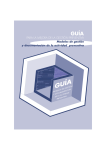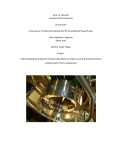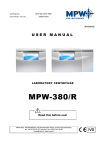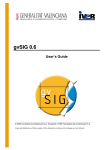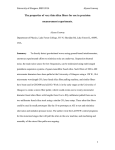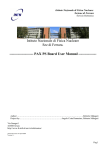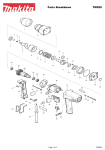Download Identifying Electromagnetic Transients Using Image
Transcript
IDENTYFYING ELECTROMAGNETIC TRANSIENTS USING IMAGE SUBTRACTION Cinthia Padilla, California State University Fullerton IREU 2011, Hosted by Seoul National University and National Institute for Mathematical Sciences (NIMS) in South Korea Advisors: Prof. Lee, Dr. SH Oh ABSTRACT Over the past several years the LIGO, Virgo and GEO600 gravitational-wave detectors have operated together as a worldwide network. The combined data from these detectors allows sky localization of astrophysical gravitational-wave sources. By running searches for transient gravitational waves shortly after the data is taken, sky locations can be communicated to electromagnetic observers early enough to allow measurement of any electromagnetic emission in the aftermath of a strong gravitational-wave signal. By measuring both the gravitational and the electromagnetic radiation we can learn a significant amount about their source. Over the past year, electromagnetic images of sky locations corresponding to lowthreshold gravitational-wave triggers have been acquired. These are now being analyzed for optical transients. Challenges include unrelated disturbances such as asteroids, satellites, clouds and other objects in space. I will describe the procedure for identifying electromagnetic transients with a pipeline based on image subtraction. 1 1. INTRODUCTION Newton described gravity as a force that acts instantaneously over long distances and causes falling objects to accelerate independent of their mass or composition. Einstein’s theory of general relativity says that gravity can be thought of the distortion of space where the acceleration by distortion is independent of the mass or composition of the falling body. When trying to picture the distortion-space theory of gravity, it is easiest to think of the sky as a spacetime fabric that bends around massive objects and that GW’s are basically fluctuations in the geometry of space-time produced when massive objects change their shape and orientation rapidly. Einstein’s theory of also says that GW’s propagate outward at the speed of light. There are some astrophysical systems such as binary neutron star mergers and supernovae that are predicted to emit both gravitational waves and electromagnetic radiation. EM radiation also propagates in the form of waves that move at the speed of light. The EM signals carry information that is difficult or simply impossible to extract from an observation with only GW detectors. The position information from the EM observation can be used to identify a host galaxy or constrain attempts to fit templates to the GW data. The combined observation of the electromagnetic and gravitational waves correlate in time and direction, they are considered counterparts and are essentially complimentary. Benefits of observing both the EM and GW from the same source increase confidence in the astrophysical origin of the GW event, and a lower threshold than the GW search, allowing and increased observational horizon. We are also able to obtain more information about the host galaxy and its distance, this information can lead to more stringent constraints on source models. Any distance estimate derived from the EM data would then set the overall scale for the energy contained in the GW signal [3]. In this paper we discuss the method and steps of image subtraction and procedure to use it for finding electromagnetic transients. The images used to test the process are from the Maidanak observatory located in the Republic of Uzbekistan and images that came with a downloaded package of XConvolve. Maidanak images were taken over a period of several days, at the same time of day with an exposure time of 120 seconds. And after the methods and process were well understood, we used them on images taken by the QUEST telescope. Once we find what part of the sky we would like to analyze, we obtain images using a telescope that records the image in a charge coupled device, otherwise known as a CCD chip in a fits file with other relevant information. Once the image and its information are obtained, they are considered raw data. From here we run the image through a series of procedures know as preprocessing. After the preprocessing is completed, the image moves onto post-processing. The post-processing procedure includes sub-procedures that involve correction, calibration and photometry among others. Both the preprocessing and post-processing are known as data reduction, which is simply removing unwanted and unnecessary data. Following the data reduction is the analysis of the resulting image. The analysis includes determining if an EM transient has gone through the specific part of the sky, 2 2. PURPOSE Our goal is to identify any electromagnetic transient within the given images. The transient would be evident as excess brightness after we subtract the images that were taken throughout several days and find changes. In other words, if our resulting subtracted images are blank, the original images were identical and there was no transient. 3. PROCEDURE 3.1 Preprocessing € The entire preprocessing system is done with the program IRAF. IRAF stands for Image Reduction and Analysis Facility and it is basically a general-purpose software system for the reduction and analysis of astronomical data. Images are preprocessed in order to remove unnecessary data to obtain better image quality before the post-processing where the image subtraction is done. This is done because the CCD chips are not perfect, and it is our job to only obtain pure data. It is important to remember that when choosing what images to analyze, they must all be of the same filter, in our case; we used the “V” filter. And before we can start improving the images, we must calculate some necessary parameters, the red noise and gain. These will be constantly asked for throughput both the preprocessing and post-processing procedures. σ (F + F ) − (B1 + B2 ) Gain = 1 22 F12 = (F1 − F2 ) B12 = (B1 − B2 ) RN = Gain ∗ B12 2 (σ F12 − σ B12 ) 2 The values for all of the variables, including the standard deviation can be found when using the function imhead lo+, this is the data of the image can be seen. σ is the standard deviation of the image, the B is for the bias and the F is for the flat. Any two images within the same filter € € € can be chosen, one is assigned the number one, and the other two. € 3.1.1 Zerocombine The first step we take in preprocessing is combining the bias frames into an average frame. This has to be done to remove the current accumulated before the exposure. To combine the bias frames we use the zerocombine option within IRAF. The parameters that we would like to change are done using the command epar, which simply stands for editing parameters. The default parameters result with all images with the type zero being averaged together, but with the highest value being ignored when forming the average for any given pixel. In other words, if we have ten bias frames, nine will be averaged in producing the value for each pixel in the resulting zero image. This step helps us keep radiation events out of our average bias frame. The final zero image will be a 32-bit real image. 3 Figure 1: Screen shot for setting parameters for zerocombine in IRAF 3.1.2 DarkCombine After the zerocombine process is completed, we move onto the darkcombine. The dark frames are long exposures taken with the shutter closed. Dark current accumulates with along with exposure time and is an addition to random and unwanted noise. The good thing about the zerocombine feature is that it is smart enough to select only the dark frames and will combine them scaling by the exposure times if they are different. But in the particular set of data that we are working with, the Maidanak images and the QUEST images, there was negligible dark current due to short exposure times and high quality CCD chips. 3.1.3 Flatcombine The next step is flatcombine. This process is much like the zerocombine and it processes all of the flat field images. The purpose of this step is to correct for non-uniform sensitivity and be able to obtain uniform brightness throughout the image. This also allows for the possibility that lamps providing the flat-field illumination have varied during the series for exposures, an assumption that is often true. By scaling these to a common value we obtain a less biased average given that we are rejecting some pixels. After obtaining the flat images, we are able to apply flatcombine to obtain one average flat image. 4 Figure 2: Screen shot of a flat combine image 3.1.4 Object Correction After we use all of the “combines” we proceed to Object Correction. Object correction is simply the process in which the zerocombine and flatcombine images are subtracted from the raw images. This image is then opened up in the fits viewing softwareDS9 alongside an original image without any type of correction to visually compare, and see for ourselves that everything is going as expected. Figure 3: Screen shot of a view of DS9 of zero and flatcombine applied on the right and the original on the left 5 3.1.5 Object Combine and Align The next step after the object correction is to align and combine the images. This is done because the telescopes we are using to obtain the images are not perfect. They can easily be moved over the course of several days enough to alter the position in the sky that it is pointed to. All of the images may look the same to the naked eye, but we must test to make sure. Here we will combine images to create a reference image so that we can be able to compare to all others for the transients. We must now create a reference image. The reference image consists of the combinations of images, and the more images that we combine, the better the reference image. By the end of this step we should have a reference image and several uncombined object images. In order to align the images, we must first choose an image to use as a reference. After choosing an image, we use the function epar imexam in IRAF. This function allows us to obtain the coordinates of different stars in the same image and store them in a coordinate file. This is then repeated with the rest of the images that we are analyzing. Figure 4: Screen shot of parameter settings in IRAF for imexam, they determine where the data will be stored After obtaining the coordinates from several images of the same stars, we use an Excel spreadsheet to find the difference in the location of the stars. Once the differences are acquired we place them in an .shf file then use it in the function epar imcombine, which is where all of our images become one. 6 Figure 5: Screen shot of parameter settings in IRAF for the alignment of images 3.2 Post-processing 3.2.1 Source Extractor The first step in post-processing is to run the object and reference image that resulted from the preprocessing, through a program that is called Source Extractor. Source Extractor, abbreviated Sextractor, is used to build a catalogue of objects from an astronomical image. It was designed for the reduction of extensive galaxy-survey data, but it is also good for more crowded star fields. It has pixel-to-pixel photometry, which is perfect for our research. The way that Sextractor works is by passing through the data twice. The first time it goes through, a model is built and global statistics are estimated, and the second time the background is subtracted, filtered and thresholded. Detections are then de-blended, cleaned, photometered, classified and finally written into an output catalog. This catalog contains, among other things, the position and magnitude of identified bright objects [4]. The great thing about Sextractor is that we can easily set the parameters and then run the program. Below are screen shots that show the parameter settings and also an example of the command to run it. 7 Figure 6: Screen shot of parameter catalog settings in SExtractor Figure 7: Screen shot of the SExtractor output files and image settings 8 Figure 8: Screen shot of the command to run SExtractor After the parameters are set and the program is run the outputs include a catalog file and a fits image. The catalog file now contains information such as the magnitude and coordinates of the stars, essential for data analysis. The fits image is simply to separate the background from detected stars. In the screenshot, the image on the left is the original after preprocessing, and the right is the Sextractor output. Figure 9: Screen shot of SExtractor's output catalog Figure 10: Screen shot of SExtractor's image output next to the original image 9 3.2.2 Xconvolve After the catalog files are completed, the following step is image subtraction by crossconvolution. Cross convolution is when two convolution kernels are generated to make a test image and a reference image separately transform to match as closely as possible. We were able to locate a pre-written source code that runs within the program IDL that would make the cross convolution very simple. IDL is a programming language for the creation of scientific data visualization from complex numerical data. The aim of the cross-convolution code, known as Xconvolve, is primarily for the reliable identification of transients in a very large database, not precise photometry [1]. Flat field images are processed in the previous step with Sextractor to create object lists with precise stellar coordinates. The Xconvolve routine uses the IDL function “POLYWRAP” to warp the images and overlay stellar objects as closely as possible. Then a valid pixel map is made to avoid pixels close to the image perimeter and screen against saturated values. Then the code performs image flux normalization to equalize the mean values of the two images under comparison, thus the subtraction. When it comes to image subtraction, done in the cross-convolution process, it is important to know what is happening to the background because if it is not well taken care of, it can appear to be a transient when it is only bad background reduction. Although most background sky intensity is estimated in Sextractor, it tends to be poorly estimated around the cores of bright galaxies. This problem was addressed in the code by removing the background differences between the two images instead of removing them individually. After, the sky images are scaled so that stellar fluxes match a sky difference map is generated by first performing pixel-to-pixel subtraction [2]. Like most source codes, Xconvolve does what it can and the rest is up to us. This is especially true when working with imperfect images. At this point, visual inspection is crucial. We must now open the resulting convoluted image in the visual DS9 program to identify possible transients. 10 The following image is an example of one after subtraction. The outlined stars are the only ones that are considered to be possible transients. Figure 11: Screen shot of XConvolve's output image The reason that the others can be easily excluded is that once visually analyzed, we see that they are cause by either overexposure or because the images were not aligned properly. Figure 12 is an example from the previous image of saturation. Figure 13 is an example of the result when images are not properly aligned, and finally the figure 14 is our possible transient. Figure 12: Saturated section 11 Figure 13: Bad alignment section Figure 14: Possible transient Following the cross-convolution process we run the image through SExtractor. This is so that we can obtain the data from all of the apparent transients (including the ones that we already ruled out). We then locate the possible transients on the new catalog file whose coordinates we obtained from visual inspection in the DS9 program and create a graph of pixels versus ADU’s that represents a light curve. Light curves are useful because they can be compared to astrophysical models to help us identify the transient source. The subsequent graph below is the light curve of a possible transient. Figure 15: Screen shot of graph made in IDL. It represents a possible transient source's light curve 12 4. SUMMARY The entire process can be summarized in the following figure. Zerocombine (Raw, Glat, dark images from scope) Darkcombine Preprocessing Flatcombine Object Correction Object Combine and Align Sextractor Create Reference and Object Images Catalog Files Visually Analyze Resulting Image for Realistic Transient Possibilities Xconvolve Image Subtraction Run SExtractor again Make realistic light curve to Gind source 5. CONCLUSION It is important to understand that I am unable to share any of the actual QUEST telescope images that are the property of LIGO and whether we found any real electromagnetic transients that pointed us to gravitational waves. With that aside, this paper describes in detail the methodology used to find optical electromagnetic transients. Studies show that, while the GW position reconstruction is imprecise, it is sufficiently accurate for most even source positions to be observed with technology that is used now and an aggressive observing plan. Reports on the analysis of the QUEST images will be reported in future publications. The scientific rewards of joint GW and EM observations are immense and will become accessible in the near future. 13 6. Acknowledgements This project was made possible by the National Science Foundation through the University of Florida’s IREU program. The author gratefully acknowledges the support of the National Science Foundation for the construction and operation of the LIGO laboratory, the Science and Technology Facilities Council of the United Kingdom, the Max-Planck-Society, and the State of Niedersachsen/Germany for support of the construction and operation of the GEO600 detector, and the Italian Istituto Nazionale di Fisica Nucleare and the French Centre National de la Recherche Scientifique for the construction and operation of the Virgo detector. The authors also gratefully acknowledge the support of the research by these agencies and by the Australian Research Council, the Council of Scientific and Industrial Research of India, the Istituto Nazionale di Fisica Nucleare of Italy, the Spanish Ministerio de Educaci´ on y Ciencia, the Conselleria d’Economia Hisenda i Innovaci´ o of the Govern de les Illes Balears, the Foundation for Fundamental Research on Matter supported by the Netherlands Organisation for Scientific Research, the Polish Ministry of Science and Higher Education, the FOCUS Programme of Foundation for Polish Science, the Royal Society, the Scottish Funding Council, the Scottish Universities Physics Alliance, The National Aeronautics and Space Administration, the Carnegie Trust, the Leverhulme Trust, the David and Lucile Packard Foundation, the Research Corporation, and the Alfred P. Sloan Foundation. C. Padilla is also supported by the Luis Stokes Alliance for Minority Participation program. The author would lastly like to gratefully acknowledge Dr. Hung Mok Lee at Seoul National University in South Korea for supervising the project as well as SangHoon Oh and John J. Oh at the National Institute for Mathematical Sciences in South Korea. REFERENCES [1] Astronomical Image Subtraction by Cross-Convolution Fang Yuan and Carl W. Akerlof, April 10, 2008 [2] Astronomical Image Subtraction by Cross-Convolution Fang Yuan and Carl W. Akerlof, January 1, 2008 [3] Implementation and Testing of the First prompt Search for Electromagnetic Counterparts to Gravitational Wave Transients LIGO Scientific Collaboration, Unpublished [4] SExtractor User’s Manual E. Bertin, 2006 14














